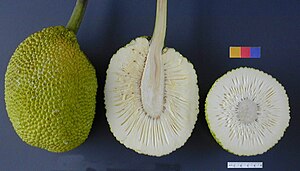Cookbook:Breadfruit
| Breadfruit | |
|---|---|
 | |
| Category | Fruits |
Cookbook | Recipes | Ingredients | Equipment | Techniques | Cookbook Disambiguation Pages | Ingredients | Fruit | Basic foodstuffs | Vegetable
Breadfruit, sometimes called tree potato, is the fruit of the tropical tree Artocarpus altilis. It is native to East Indian and Pacific islands and has been widely planted in tropical regions everywhere. It is easily confused with jackfruit, but the two are used differently.
Characteristics
editThe grapefruit- to soccer ball-sized ovoid fruits have a bumpy yellow-green surface, starchy white flesh, and tough core.[1][2] Much of the breadfruit grown by Pacific Islanders is a seedless variety, though seeded varieties do exist.[1]
Breadfruit can be eaten at multiple stages of maturity. When underripe, the fruit is firm and greenish yellow, and its flesh is starchy. When ripe, it softens, sweetens, and turns brown-yellow.[1]
Varieties
editThere are several varieties of breadfruit, including the seedless Pacific breadfruit, the seeded breadfruit or breadnut, and the African seeded breadfruit.[3] The African breadfruit has harder flesh and is usually grown for its seeds.
Selection and storage
editUnderripe fruits should be firm to the touch with a yellow-green tinge. They should be stored in a cool place or in the fridge.[1] When ripe, they should be soft and sweet with a brown-yellow color.[2] Ripe fruits should be used immediately. Once cooked, the fruit will keep for longer and can even be stored in the freezer. Breadfruit can even be dried and ground to a flour.[1]
Use
editBreadfruits are a staple food in many tropical regions. The underripe seedless fruits are very rich in starch and must be cooked, usually in savory preparations where they can be roasted, boiled, stewed, fried, and more[1][2]—the taste is described as potato-like. The fully ripe fruits are sweet and can be eaten raw or used like other culinary fruits in pies, custards, etc.[1][2] Breadfruit have historically been fermented, and they may now be canned. The seeds of the seeded varieties can also be eaten,[1] as in Nigeria where it often goes by the term "ukwa".
Because of its sap, breadfruit needs some special preparation. It should be soaked in cold water for a few minutes before cutting to remove any residual sap from the outside.[1] The stem should then be snapped off and the fruit turned upside down to allow any sap to drain from the hole for a full day before cutting and cooking it.[2]
Gallery
edit-
Steamed breadfruit
-
Stewed breadfruit
-
Fried breadfruit
-
Breadfruit chips
-
African breadfruit seeds
Recipes
editReferences
edit- ↑ a b c d e f g h i "Breadfruit". FoodPrint. Retrieved 2024-01-11.
- ↑ a b c d e Geib, Claudia (2023-04-12). "Everything You Ever Wanted to Know About Breadfruit". Eater. Retrieved 2024-01-12.
- ↑ Ojimelukwe, Philippa C.; Ugwuona, Fabian U. (2021-08-19). "The traditional and medicinal use of African breadfruit (Treculia africana Decne): an underutilized ethnic food of the Ibo tribe of South East, Nigeria". Journal of Ethnic Foods. 8 (1): 21. doi:10.1186/s42779-021-00097-1. ISSN 2352-6181.